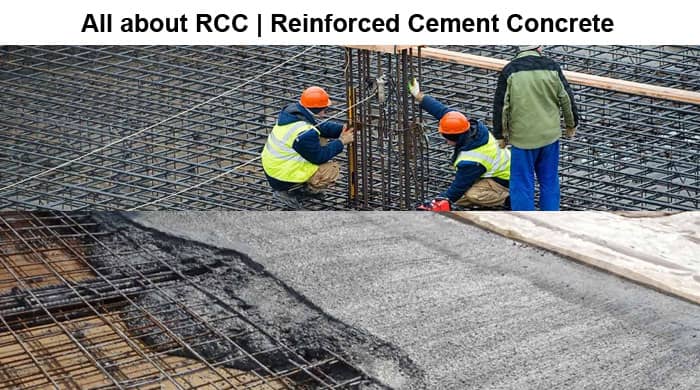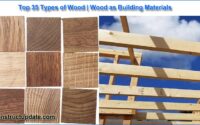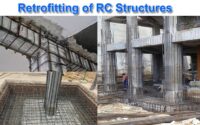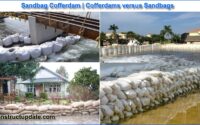All about RCC | Reinforced Cement Concrete | Materials | Advantage | Disadvantages | RCC Vs Concrete
What is Reinforced Cement Concrete (RCC)
Reinforced Cement Concrete (RCC) is a composite building material made of structural concrete that has been strengthened with a reinforcing substance like steel. Due to its complementary qualities, steel is the most frequently utilized reinforcement, and the material is known as reinforced cement concrete or just reinforced cement.
Reinforcing bars or reinforcement are steel bars inserted into concrete. Read more about why steel is appropriate for reinforced concrete here. There are two main types of reinforcing bars: (a) mild steel and (b) high yield strength steel. Additionally utilized as reinforcement in RCC is steel fabric formed from cold drawn steel wires that are welded to create a mesh. Concrete with fiber reinforcement is also widely used in the building sector.
Materials Used in RCC (Reinforced Cement Concrete):
- Cement
- Aggregates
- Admixtures
- Steel
- Water
What is Reinforced Cement Concrete (RCC) used for?
For all bending-prone structural elements, reinforced concrete is used. Reinforced cement concrete is used in the construction of everything from lightweight structures like bridge piers, girders, and dams to heavy ones like beams, columns, slabs, shear walls, and foundations. Precast concrete or in-situ concrete can both be made of reinforced cement.

Advantages of RCC
- Comparatively speaking, reinforced concrete outperforms other building materials in terms of compressive and tensile strength.
- RCC structures are more resilient than other structures.
- Before the mix hardens, reinforced concrete can be molded into any shape.
- RCC structures are durable and require little upkeep.
- RCC structures are more fire-resistant than just steel ones.
- Compared to the construction of steel structures, RCC buildings require less skilled people.
Disadvantages of RCC
Reinforced concrete’s tensile strength is only around one-tenth that of its compressive strength.
Building using RCC entails a number of procedures, including mixing, casting, and curing. If any of these stages are missed, the RCC’s final strength may change.
The added expense of setting up formwork before pouring concrete and taking it down afterwards.
RCC buildings that have shrunk after hardening may develop cracks and lose strength.
Fresh concrete can be poured and moulded into any shape because it will be in the form of a fluid. The engineer can more easily choose the shape of a structure based on architectural considerations.
Weather and fire resistance: RCC will endure a fire for around 3 to 4 hours with the correct protection. When quality assurance and durability are properly taken into account, RCC will also endure any weather.
Maintenance: Compared to other types of constructions (steel and timber), concrete structures require less upkeep when construction is complete.
Availability: Steel and concrete are widely utilized in building, making reinforced cement concrete simple to prepare.
Economical: Compared to other materials, like steel, it is more affordable.
Rigidity: Due to their stiffness, reinforced concrete members have good rigidity.
What is Concrete?
The most widely utilized building material is structural concrete, which is used up at a pace of roughly one ton for every person still alive. Water is the only material that man uses in such massive amounts. The most significant building material, concrete is used in every infrastructure project. It is moldable into many shapes when the appropriate formwork is used.
Concrete is a mixture of cement, fine aggregate (sand), coarse aggregate (boulders or gravel), and water that solidifies into a strong mass as a result of cement’s hydration. In addition to these components, numerous admixtures are also added to concrete to improve its workability, durability, setting time, and other features.
Why is Reinforced Cement Concrete better than Concrete?
While it is weak in bending, plain concrete is strong in compression. It is too weak, with a tensile strength that is only about one-hundredth of its compressive strength. Simple concrete members generate cracks and ruptures when they are bent.
Plain concrete is not used in places where bending action is possible for the same reason. The capacity to withstand bending forces is referred to as tensile strength.
Tensile stresses are produced in flexural members, such as beams and columns, by bending forces. When reinforced with steel, which is more than a hundred times stronger in tension than concrete, ordinary concrete’s overall capacity for bending is increased.
Steel bars function monolithically with concrete to make up for the concrete’s lack of tensile strength by effectively taking on all the tension. In order to act against forces, concrete, and steel bars working together produce good strength. Similar to how human bones support the surrounding tissue and bulk.





